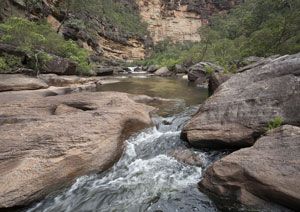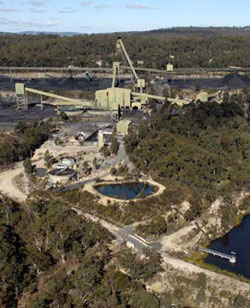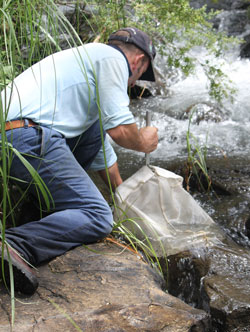Environment Protection Licence (EPL726)
(submissions closed on 21 November)
- Protect The Wollangambe -
 The Wollangambe River - photo by Ian Brown
The Wollangambe River - photo by Ian Brown
It is just to the north of Mt. Wilson and for most of its 57km length it is within the Blue Mountains and Wollemi National Parks and the Wollemi Wilderness.
The Wollangambe rises near Clarence and flows east until it joins the Colo River, which empties into the Hawkesbury River near Lower Portland.
Here's a map of the Wollangambe River
 The Clarence Colliery
The Clarence Collieryphoto courtesy of Centennial Coal
The Clarence Colliery is owned -
• 85% - Centennial Coal
• 15% - SK Energy Australia
Centennial Coal is owned by Banpu (Thailand).
SK Energy Australia is a subsidiary of SK Holdings Co Ltd (Korea).
Clarence Colliery is an underground mine, and extracts about 2 million tonnes of thermal coal annually.
Coal is shipped to Port Kembla by rail, and by road to domestic customers.
The mine has about 20 years of marketable reserves.
 Dr. Ian Wright sampling
Dr. Ian Wright samplingphoto by Nakia Belmer
The wastewater increases salinity, metals, pH and water temperature.
Downstream of the contamination point, the ecosystem of the river, as reflected by aquatic macroinvertebrates, is adversely affected.
The pollution is detailed in this peer reviewed paper.
Four sampling sites were selected for the study. One upstream of the mine discharge point - this provided a reference site. Three sites below the mine at approximately 0.1 km, 1.0 km and 16 km.
Macroinvertbrate abundance was more than 90% lower downstream of the coal mine discharge point.
The reference site was acidic with a mean pH 5.6. In contrast the site immediately below the mine discharge was alkaline with a mean pH of 7.9
Reference concentrations of nickel and zinc were generally below or just above the laboratory limits of detection at the upstream reference site. Both zinc and nickel concentrations below the discharge point exceeded the ANZECC guidelines that suggest the levels would be hazardous for aquatic ecosystems.
Water temperature results indicate sites below the wastewater discharge point were considerably warmer than at the reference site, indicating the occurrence of thermal pollution.
Alarmingly, the abundance and family richness of macroinvertebrates, salinity, water temperature and nickel aren't in the current licence. And pH and zinc are allowed at very high levels.

The review is focusing on the discharge of pollutants into the Wollangambe River.
The EPA is proposing to vary the EPL to put in place limits on nickel, salinity, and temperature of the discharge, as well as introduce a legally-binding Pollution Reduction Program requiring the company to reduce the concentration of pollutants in the discharge.
